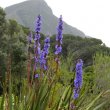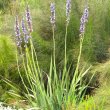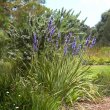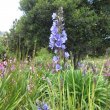| Botanical Name |
|
| Family |
Iridaceae - The iris family. |
| Pronunciation |
air-ISS-tee-uh kap-ih-TAY-tuh |
| Common Name(s) |
Afrikaans: Blousuurkanol; Bloukanolpypie
|
| Plant Group |
- Bulb / Corm / Rhizome / Tuber / Epigeal bulb Bulbs: are made up of fleshy scales as in an onion
Corm: a short, swollen, underground stem that is hard and not fleshy as in a gladiolus
Tuber: a solid, fleshy, underground, storage organ as in a potato
Rhizome: an underground, horizontal, swollen stem at the base of the plant as in an iris
Epigeal bulb: bulbs that rest above the ground with only the roots anchoring the plant to the earth as in albuca
|
| Plant Size |
- Very large
| Tree | Over 25m |
| Shrub | Over 4m |
| Perennial/ground cover | Over 1m |
| Bulb | Over 1.2m |
| Succulent | 1.5m to 2m |
|
| Position |
- Partial Shade The area is in shade for part of the day and in full sun for part of the day.
- Sun The area is in full sun for all or most of the day, all year round.
|
| General Information |
- Drought Tolerance: Moderate The plant is moderately adapted to arid conditions and can survive short periods of drought and high temperatures without extra water.
- Evergreen Plants that have leaves all year round.
- Frost: Tender A plant that will not survive any frost or low winter temperatures.
- Roots Non-invasive Safe to plant near pools, paving, walls or buildings.
- Water Loving Plants need a regular supply of water and must not be allowed to dry out for any length of time.
- Wind Tolerant Plants able to withstand the effect of strong winds.
|
| Specific Information |
Aristea capitata is a clump-forming perennial with erect, leathery, strap-like, mid-green leaves arising from underground rhizomes. The spike-like flower stems can reach up to 2 meters. The flowers open in the morning and by the afternoon they start to wilt and close, with new flowers opening the next morning. The old flowering stems remain upright for months, turning a rich brown colour.
|
| Ad Break |
|
| Flowers |
| Description |
flat saucer-shaped blooms of about 25 mm tightly arranged on little branches forming small bunches along the upper part of a spike up to 1,5 meters tall
|
| Season |
- Spring to Summer Plants will seldom bloom for the entire season as given in the list, but should flower during a period within these parameters.
|
| Colour |
|
| Growth Rate |
- Moderate Specifying growth rate can be very misleading as there is considerable variation of growth rate depending on type and species of plant, available water, supplementary feeding, mulching and general care, as well as the plants suitability and adaptability to the garden environment.
|
| Plant Uses |
- Attracts bees, butterflies or other insects This plant attracts insects which can be food for birds or other creatures in your garden.
- Border A strip of ground, at the edge of a driveway or path in which ornamental plants or shrubs are planted.
- Container Trees, shrubs and ornamental species that can adapt to growing in a restricted environment.
- Filler Either a fast growing tree or shrub used temporarily to fill in an area while the permanent plants grow to a desired size, or a plant used to fill gaps in borders or beds.
- Wild Garden An indigenous garden planted for the benefit of wildlife and birds. Provides food, water, a variety of mini-biomes and no poisonous chemicals are used.
|
| Distribution and Habitat |
in the southwestern part of the Western Cape, on the lower grassy mountain slopes
|
| Planting Suggestions |
Aristea capitata does best planted in full sun in rich soil to which compost has been added. Water regularly, especially during the winter and spring. Lift and divide mature clumps after flowering but only if really necessary. Make sure that the rhizomes do not dry out and re-plant immediately. Keep moist until the plants are established and show signs of new growth.
|
| Medicinal Uses |
|
| Ad Break |
|








Discuss this plant
Share knowledge, ask a question or give an experience.